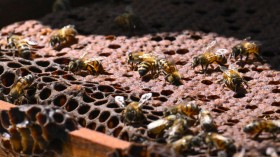Virginia currently has an invasion problem, not by Martians or other hostile aliens, but by small, venomous caterpillars that seem to look like walking toupées.
Dangerous "Toupees."
This strange little crawling insect may have a funny appearance, looking like a bald person's artificial hairpiece that ran amok, but the venomous pus that it squirts from the knife-like spines it possesses is nowhere near amusing, especially to its victims.
The VDoF or Virginia Department of Forestry says that it has received several reports of the presence of the caterpillars in some counties in eastern Virginia. This vermin is the larva of Megalopyge opercularis or southern flannel moth. It has pus that it shoots from its "hairs," which are stinging spines that serve as its defense against predators and other enemies.
READ: Discover What Makes Human Blood Attractive to Mosquitoes
A Painful and Toxic Sting
The general public is advised to avoid these creatures at all costs. This larva is the most venomous United States caterpillar. A New Kent County resident was stung by its spine, and she described the feeling as akin to a hot, scorching knife slicing through her calf's outer area. The caterpillar brushed against her lower leg.
The "white-hot" sensation of pain compelled her to have her leg checked at a hospital ER. She did not feel normal until the third day after the sting.
A Local Species
The VDoF says that Virginia is no stranger to pus caterpillars. The agency reports that its northernmost range in the region has been recorded up to New Jersey.
The University of Florida reports that they are also commonly found in Florida, with their highest abundance recorded in western-central Texas.
Effect of Climate Change?
According to Virginia Tech University Insect ID Laboratory manager Eric Day, 2020 seems to be a year of insect "outbreaks." Virginia weather, along with the rest of the US, has been made warmer due to climate change.
According to Insect ID Lab researcher Theresa Dellinger, climate changes may induce changes in the population of many insects. However, she adds that it is too early to make conclusions. Butterflies, moths, and caterpillars have different cyclical life periods, which depend on the proper time and environmental conditions.
READ NEXT: Exotic Beetle is Destroying Ash Trees in North America
What to Do if Stung
According to a report from CNN, this larva's venom can be treated similarly to a bee sting. This means that people with allergic bee reactions might have the same reactions to the sting of the caterpillar.
According to a Virginia Tech publication, there are first aid measures that can be done if one is stung. These are as follows:
- Wash with soap and water to remove remaining hairs and other substances
- Put tape over the affected area and rip off the tape to remove the embedded hairs
- Repeat until all hairs are removed, using fresh tape during every application
- Apply steroid cream and ice compress to limit swelling and to lessen the pain
- If there is a history of anaphylactic reactions from insect stings and bites, or if the affected area is near the patient's eyes, immediately consult a doctor.
For the moment, the state has decided to leave the animal to its natural predators to reduce its population. However, if their spread remains unhampered, eradication might be implemented by the state of Virginia, to ensure the public's safety from these venomous caterpillars looking innocuously like walking toupées.
READ ALSO: Asian Hornet Warning: Spotted in Hampshire, Dangerous to Bees and Humans
Check out for more news and information on Insects on Nature World News.
© 2024 NatureWorldNews.com All rights reserved. Do not reproduce without permission.





